You can boost your large format 3D printer’s speed by up to 300% through strategic upgrades and optimizations. Start by upgrading to CoreXY motion systems and direct drive extruders, then increase your nozzle size to 0.6-0.8mm for higher flow rates. Optimize layer heights to 0.2mm or thicker, reduce infill density below 50%, and choose materials like PLA that handle faster speeds well. Advanced extruder systems can achieve volumetric flow rates exceeding 1kg/hr, transforming your printer’s performance and opening possibilities you haven’t yet explored.
Understanding Large Format 3D Printer Speed Fundamentals
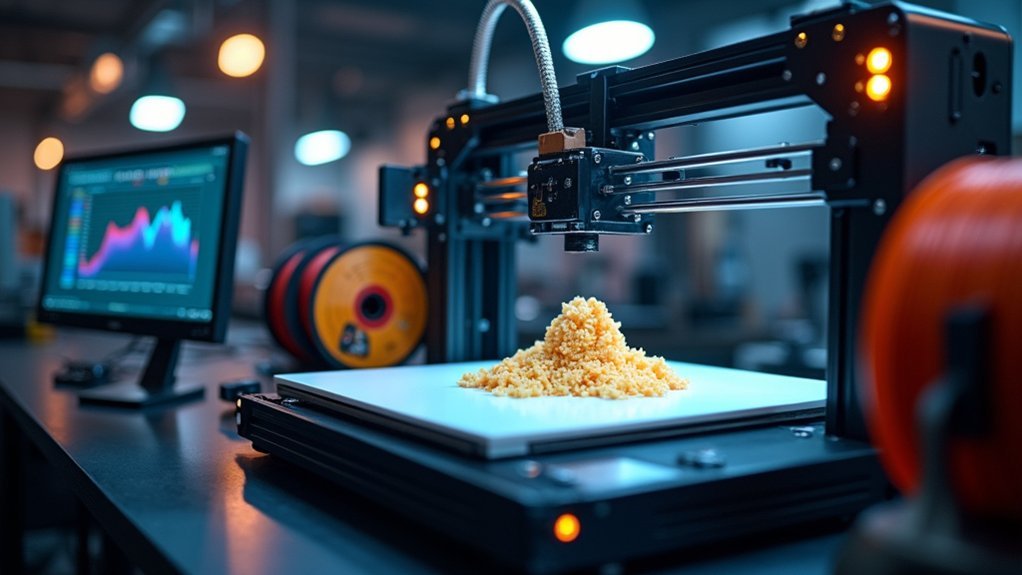
Speed limitations define the core challenge you’ll face when operating large format 3D printers, as these machines typically max out around 60 mm/s due to their mechanical constraints.
Your print speed depends on several interconnected factors that directly impact output quality. Layer height affects speed considerably—thicker layers enable faster printing but reduce surface detail. Nozzle size plays a vital role; upgrading to 0.6 mm or larger increases material flow rates, cutting print time for big parts.
Infill density optimization lets you achieve faster speeds by using lower percentages and simpler patterns without sacrificing mechanical properties. Environmental factors like bed temperature and cooling methods guarantee you maintain print quality while pushing speed boundaries on your large format machine.
Hardware Upgrades for Enhanced Motion Control
You’ll find that upgrading your motion control hardware can dramatically increase your printer’s speed and precision.
CoreXY motion systems allow simultaneous dual-axis movement for faster print times, while direct drive extruders provide better filament control at high speeds.
High-flow hotend upgrades enable you to push more material through larger nozzles without compromising quality.
CoreXY Motion Systems
Precision meets velocity in CoreXY motion systems, where a revolutionary belt arrangement transforms how your 3D printer moves. This design enables simultaneous X and Y axis movement while dramatically reducing inertia, delivering exceptional print speeds that surpass traditional Cartesian setups.
You’ll achieve higher speeds exceeding 500 mm/s through improved printhead acceleration and reduced moving mass.
The compact frame design enhances rigidity and stability, maintaining superior print quality even during rapid acceleration. Lightweight printhead components and precise belt tensioning minimize vibrations that typically compromise fast printing.
To maximize performance, upgrade to high-performance stepper motors and optimize your firmware with Klipper motion control. This combination reveals your printer’s true speed potential while preserving the precision your projects demand.
Direct Drive Extruders
While traditional Bowden setups create distance between your extruder motor and hotend, direct drive extruders eliminate this gap by mounting the extruder directly above the nozzle. This positioning dramatically improves your filament control and reduces jamming issues that plague remote feeding systems.
You’ll achieve faster print speeds through enhanced retraction capabilities, minimizing stringing during rapid movements. Direct drive extruders excel with flexible materials, maintaining good print quality even at higher speeds where Bowden systems typically fail.
The real advantage comes when you upgrade to a larger nozzle size. Direct drive systems handle increased material flow rate more efficiently, making them perfect for rapid prototyping and large-format printing.
You can push higher speeds without sacrificing precision, transforming your printer’s productivity for demanding applications.
High-Flow Hotend Upgrades
High-flow hotend upgrades take your direct drive system’s enhanced filament control and amplify it with dramatically improved melting capacity.
You’ll achieve faster extrusion rates that can double or triple your print speeds, especially with materials like PLA that melt quickly. These hotends typically feature larger nozzles (0.6mm or greater), enabling thicker layers and higher volume deposition per second.
The enhanced thermal performance maintains consistent temperatures during high-speed operation, reducing clogs and jams.
You’ll need to adjust your slicing software settings to maximize these benefits—increase print speeds and layer heights accordingly.
The combination of improved filament control from your direct drive extruder and the high-flow hotend’s superior melting capability dramatically reduces overall print time while maintaining print quality.
Optimizing Print Settings and Parameters
When you’re looking to maximize your 3D printer’s speed, adjusting key print settings offers the most immediate and effective results.
Here are four essential parameter adjustments that’ll greatly improve your print speed:
- Increase layer height – Thicker layers reduce total print time while maintaining acceptable print quality for less detailed models.
- Upgrade nozzle diameter – Moving from 0.4mm to 0.6mm or 0.8mm enables higher material flow rates, though you’ll sacrifice some detail.
- Reduce infill density – Lowering infill density below 50% considerably cuts print time by requiring less internal material.
- Optimize movement settings – Increase travel speed and choose simpler infill patterns like lines or grids to streamline print head movement during non-deposition phases.
Material Selection for High-Speed Large Format Printing
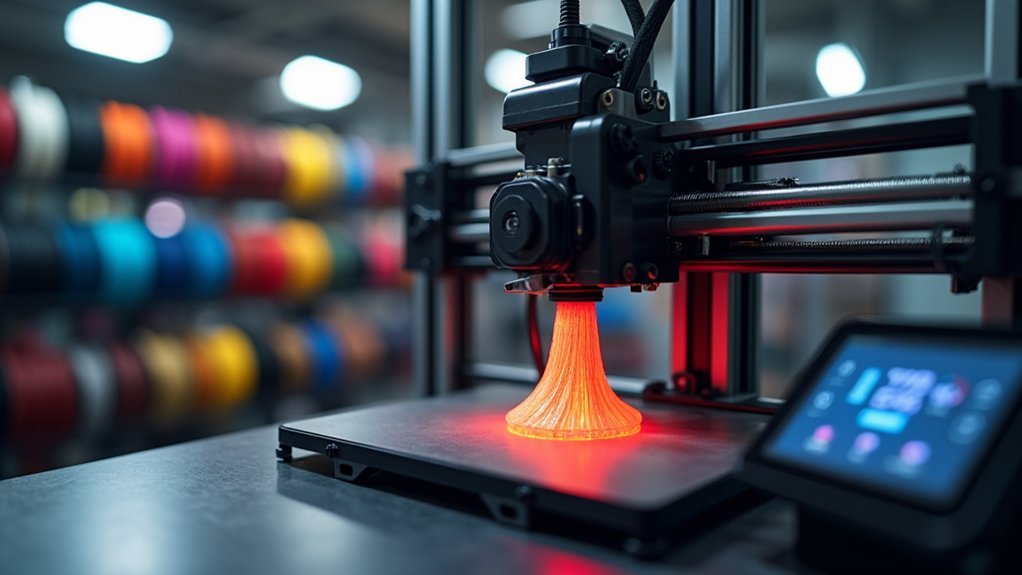
You’ll find that choosing the right materials can dramatically impact your large format printing speeds and overall efficiency.
Fast material properties like low melting points and excellent flow characteristics allow you to push higher extrusion rates without compromising quality.
Large format filaments with specific formulations can handle the demands of high-speed printing while maintaining structural integrity across bigger builds.
Fast Material Properties
Material selection forms the cornerstone of successful high-speed large format 3D printing, where the wrong choice can derail your entire project before it begins.
You’ll need materials that combine high tensile strength with properties that support fast printing without compromising structural integrity.
Focus on these key material characteristics for peak speed:
- High-flow filaments like specialized PLA blends enable smoother extrusion and prevent clogging at higher speeds.
- Low-compressibility materials reduce layer requirements, delivering reduced overall print time.
- Reinforced materials such as nylon blends provide durability while maintaining speed capabilities.
- Flexible TPU blends minimize brittleness and warping during rapid printing.
You’ll achieve faster results by selecting low-porosity materials that flow smoothly through your extruder while maintaining the structural integrity your large format projects demand.
Large Format Filaments
Three critical factors determine your success when selecting filaments for high-speed large format printing: flow characteristics, thermal properties, and structural performance at scale. High-speed filaments like PLA excel with exceptional flow properties, enabling PLA print speed up to 150 mm/s while maintaining print quality. For larger components requiring structural integrity, ABS and PETG offer ideal balance at 40-60 mm/s speeds.
| Material Type | Speed Range | Best Application |
|---|---|---|
| PLA | 100-150 mm/s | Detail parts |
| ABS/PETG | 40-60 mm/s | Structural components |
| Nylon/Carbon Fiber | 30-50 mm/s | High-strength parts |
Adjusting print settings for material-specific requirements helps reduce overall production time. Consider pellet feedstock systems to reduce overall costs by 50-75% while maximizing overall printing speed for large-scale manufacturing.
Advanced Extruder Systems and Volumetric Flow Rates
When you’re pushing the boundaries of 3D printing speed, advanced extruder systems become the backbone of high-performance manufacturing.
These systems deliver exceptional volumetric flow rates up to 1 kg/hr, dramatically boosting your printing efficiency while maintaining print quality.
Here’s how to maximize your system’s potential:
- Upgrade to larger nozzles (1.0-2.0mm) for faster material flow and thicker layers
- Install pressure transducers to automatically detect and adjust material flow inconsistencies
- Optimize continuous model designs to minimize non-print movements that disrupt flow
- Fine-tune coasting parameters to eliminate oozing while maintaining structural integrity
Advanced extruder systems transform your large format printer into a speed powerhouse.
Mechanical Improvements: Ball Screws and Linear Actuators
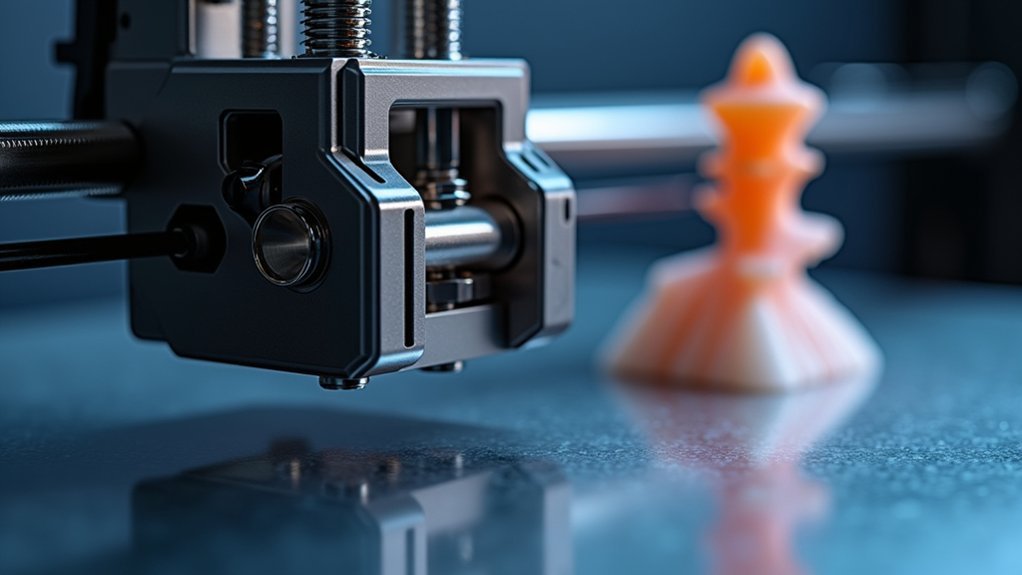
You can dramatically boost your 3D printer’s speed by upgrading its mechanical components, particularly the motion systems that move your print head and build platform.
Ball screws offer superior precision and reduced friction compared to traditional lead screws, while linear actuators provide the smooth, rapid movement essential for high-speed printing.
These precision motion control upgrades work together to eliminate the mechanical bottlenecks that typically limit your printer’s maximum speeds and accuracy.
Ball Screw Benefits
Precision becomes paramount when you’re pushing your 3D printer to higher speeds, and ball screws deliver exactly what traditional lead screws can’t.
These mechanical upgrades reduce friction greatly, enabling faster movement while maintaining exceptional print quality through smoother motion.
Ball screws transform your printer’s performance through four key advantages:
- Reduced backlash – Virtually eliminates positioning errors for consistent accuracy across large print volumes
- Higher load capacity – Supports heavier components without speed compromise
- Minimized vibrations – Smoother operation prevents quality degradation at higher speed
- Extended component life – Less wear and tear ensures long-term reliability
You’ll notice immediate improvements in both speed capabilities and dimensional accuracy.
The reduced friction allows your printer to achieve faster travel speeds while the enhanced precision maintains quality standards essential for professional applications.
Linear Actuator Upgrades
Linear actuators take the precision benefits of ball screws even further by integrating high-torque stepper motors that dramatically improve your printer’s acceleration and deceleration rates.
When your print head moves along these upgraded systems, you’ll notice notably faster movements without sacrificing precision. These actuators reduce backlash while maintaining the ability to operate at high speeds of 60 mm/s or higher.
The real advantage comes from closed-loop control systems that provide real-time feedback on position and speed.
This integration helps improve print accuracy and accelerate print times for large objects. You’ll also experience reduced friction and wear compared to traditional linear rails, leading to longer-lasting components and less maintenance downtime for your large format printer.
Precision Motion Control
While traditional 3D printers rely on basic lead screws that introduce wobble and inconsistent motion, ball screw systems deliver the mechanical foundation needed for true high-speed printing.
You’ll achieve precision motion control that transforms your large format printer’s capabilities.
Ball screws eliminate backlash and enable linear speeds up to 300 mm/s, dramatically boosting print speed.
When you combine them with linear actuators and closed-loop stepper motors, you’ll get continuous position feedback that prevents errors during the 3D printing process.
Here’s what you’ll gain:
- Reduced vibration through high-torque linear actuators
- Frictionless motion via high-quality linear rails
- Continuous feedback from closed-loop stepper motors
- Enhanced accuracy with minimal backlash
This integrated approach guarantees smoother axis movements and superior print quality.
Automatic Leveling and Calibration Systems
Automatic leveling and calibration systems have revolutionized 3D printing by eliminating one of the most time-consuming setup tasks that used to plague every print job. These systems use sensors to detect precise distances between your nozzle and bed, ensuring perfect nozzle height and bed adhesion across the entire surface. You’ll experience dramatically improved print quality while achieving faster production times.
Modern calibration systems employ mesh bed leveling, creating detailed height maps that compensate for surface irregularities. This eliminates print failures caused by improper first layer adhesion.
| System Type | Key Benefit |
|---|---|
| BLTouch Probes | Precise measurements for large formats |
| Mesh Bed Leveling | Compensates for surface irregularities |
| Auto-Calibration | On-the-fly adjustments between prints |
| Sensor Detection | Consistent first layer across build surface |
You’ll reduce material waste and switch between prints faster without manual adjustments.
Slicing Software Optimization for Large Scale Prints
Once your printer’s hardware is optimized, your slicing software becomes the command center that determines whether large-scale prints finish in hours or days.
Strategic parameter adjustments dramatically impact your print speed without sacrificing quality.
Fine-tuning your slicer settings can slash print times while maintaining the surface quality your project demands.
Here’s how to maximize your slicing software efficiency:
- Adjust layer height to 0.2mm or thicker for large prints, balancing speed with acceptable detail levels.
- Choose simple infill patterns like grids or lines instead of complex honeycombs to reduce printhead movement.
- Increase travel speeds during non-deposition moves to minimize idle time between print areas.
- Optimize orientation and reduce support structures using your slicer’s analysis features to decrease material usage.
Configure your print speed and infill speed settings aggressively for non-critical sections while maintaining quality parameters for visible surfaces.
Environmental Controls and Print Chamber Management
Beyond optimizing your slicer settings, controlling your printer’s environment becomes critical for maintaining consistent speeds during extended print sessions.
Your print chamber’s temperature stability directly impacts layer adhesion and prevents warping, especially with ABS and Nylon materials. You’ll need proper ventilation and cooling systems to manage heat buildup during long jobs, preventing extruder and heated bed overheating.
Consider installing insulated walls or heated enclosures to maintain consistent temperatures, reducing the need for excessive layer cooling that slows printing.
Monitor humidity levels carefully, as moisture degrades hygroscopic filaments like Nylon and PETG, causing print failures.
Implementing automated environmental controls with temperature and humidity sensors linked to your control system optimizes conditions for different materials, maximizing both speed and quality.
Performance Testing and Speed Validation Methods
How can you verify that your speed enhancements actually deliver the performance gains you’re targeting? Performance testing provides concrete data to validate your improvements and identify bottlenecks that limit your printer’s potential.
Effective speed validation requires systematic measurement across multiple variables:
- Benchmark standard test prints using calibration cubes and complex geometries to establish baseline print speeds and times.
- Monitor print quality indicators including layer adhesion, stringing, and dimensional accuracy at various speeds to find ideal balance points.
- Track material flow rates using slicer software to visualize layer times and identify processing constraints across different filaments.
- Conduct regular calibration of stepper motors and thermal systems to maintain consistent performance as you push speed boundaries.
Compare results across materials since PLA tolerates higher print speeds than temperature-sensitive filaments like ABS.
Frequently Asked Questions
How Can I Speed up a Large 3D Print?
You can speed up large 3D prints by increasing print speeds to 50-180 mm/s, using larger nozzles, reducing infill below 50%, optimizing part orientation, and minimizing support material requirements.
How Can I Increase My Printer’s Print Speed?
You can increase print speed by raising your slicer’s speed settings to 100-150 mm/sec, using larger nozzles like 0.8mm, reducing infill below 50%, and switching to faster materials like PLA.
How Do You Change the Speed of Your 3D Printer?
You’ll change your 3D printer’s speed by adjusting print speed settings in your slicing software’s Speed section. Select values between 50-150 mm/s depending on your material for best results.
What Speed Should I Run My 3D Printer At?
You should run your 3D printer at 60 mm/sec for PLA as a starting point. You can push speeds up to 150 mm/sec with proper hotend upgrades and settings adjustments.

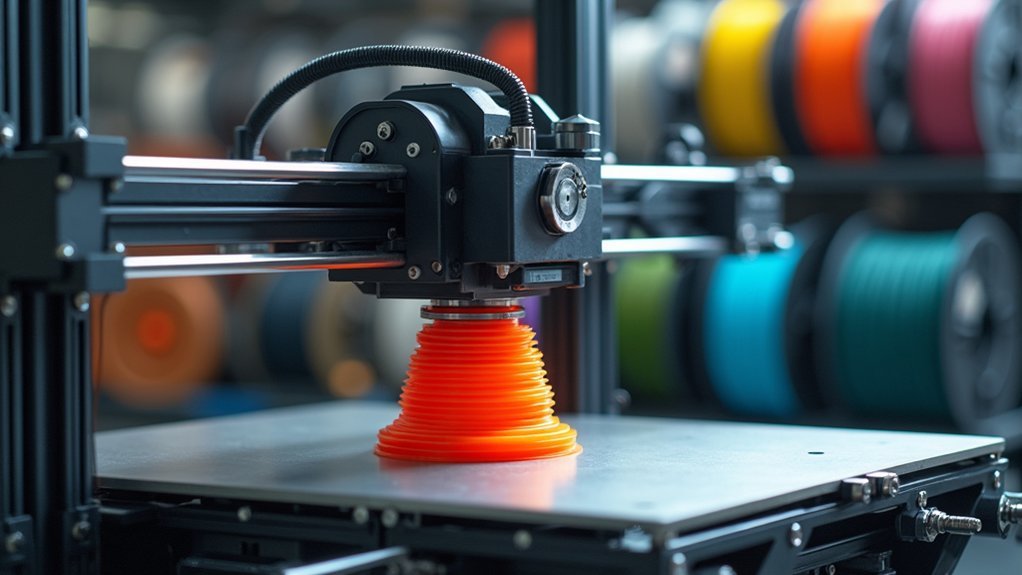


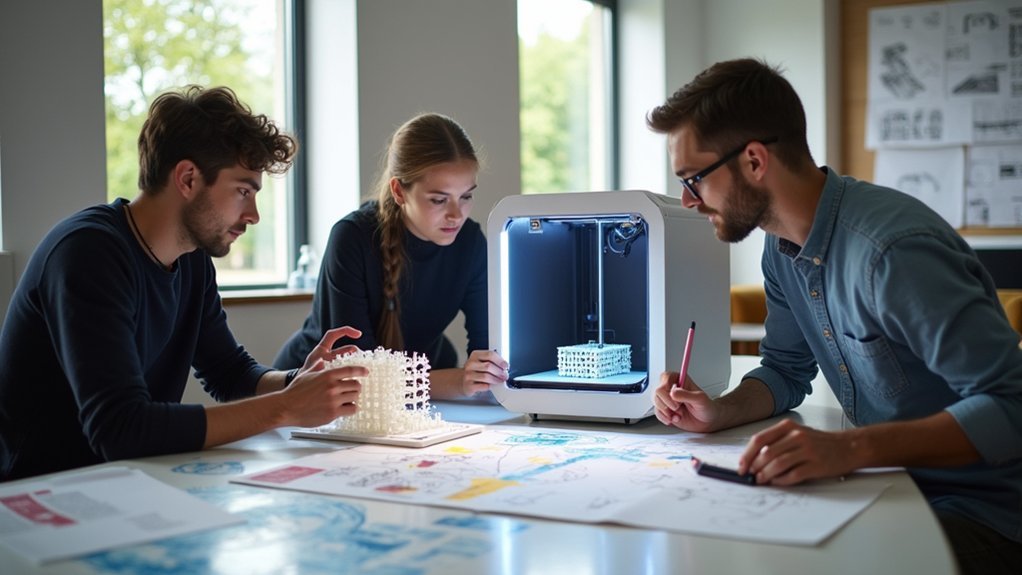
Leave a Reply